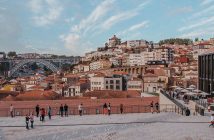Clutching his new 3-day tourist visa, David Constable jets off to China’s commercial capital and spends his time exploring the back streets and markets of Shanghai’s French district…
What strikes me each time I visit China is how the plain mundanity of its people and their lives captures so vividly the tapestry and unfolding of its big cities. You learn more from the businessman on his rickety bicycle and the old women in pyjamas selling dragonfruit and cherries by the roadside, than from any guidebook.
Shanghai is full of such characters. It’s one of the world’s great metropolises, with a population of over 27 million people – almost four times the size of London – and an ever-changing neon-lit skyline that climbs through the clouds like an expansion game of The Sims. For a true reflection of the city, however, look beneath the skyscrapers and penthouses of lofty buildings, to street level.
To discover this city and its millions of inhabitants, go to the markets, street vendors and back-alleys. See where the locals live, shop and eat. Sharpen your elbows and walk into the crowds of the Tianzifang market.
Tianzifang is a labyrinthine district in the French Concession area of the city, and comprises of a maze of pedestrian off-shoot avenues and dead-ends; littered with quirky independent stores, novelty boutiques and lane houses. There are authentic Chinese clothes shops and rare tea shops, pop-up bars and candy stores, and rows of bizarre stalls selling multi-coloured anime: all the clothing, phone-covers, toys, masks and tac you can possibly imagine. I’ve never seen so many grinning Sponge Bob faces starring back at me.
Markets are always the best and truest of places. They’re where you discover what a country has and doesn’t have, what the people buy and sell, what they eat and don’t eat. And they eat a lot of things here: varying styles of Benbang and Haipai Cuisine; dumplings, buns and jianbing, a deliciously spicy-style crepe, slathered in unami-laden soybean paste and chilli flakes. And there’s deep-fried, well, EVERYTHING.
In the food markets I see more animal organs and butchered flesh than a Fergus Henderson kitchen. There are pig noses, ears and tails; and chicken thighs, legs and feet. There are tanks of writhing, agitated eels; the dead jelly eyes of small, large, flat, fat fish; and a disturbing scene of two shelless tortoises pawing desperately against the glass of their enclosure.
In the afternoon I’m treated to a massage at The PuLi Hotel’s Anantara Spa. It’s 90 minutes of leg pummelling by a lady who stands only as tall as my hips, but is as strong as a black-belt. I continue to indulge and recuperate by taking lunch at Jing’An, the hotel’s namesake restaurant over-looking Jing’An park. Below me a sprawl of elderly residents in the park have dropped their sticks and frames for a few minutes of wobbly thai-chi.
Hoping to replicate the local culinary customs, I follow a nation’s resolutely epicurean devotion and slurp loudly through a hot broth of wonton noodle soup. Then, bravely, swallow a whole one-hundred-year-old egg without gagging, vomiting or regurgitating it across the table.
The PuLi Hotel is China’s first “Urban Resort Concept” offering guests a tranquil intimacy within one of the city’s busiest districts. The website describes the building’s ideology as a place where old and new combine, where “tradition meets innovation” and “design and decoration have unique stories to tell”. It manages to brainwash you into thinking you’ve left the city, that the noise and the traffic and the insanity of its 27 million population are in fact not on your doorstep; that you’re in a retreat in which they serve you juniper cocktails and luxurious homemade marshmallows.
Post lunch I act on the recommendations of locals and visit the ‘fake market’ on Nanjing Xi Lu. It’s pretty self-explanatory, as well as surely, highly illegal. It’s more of a mall than a market, with escalators and cash machines just as you’d find in any twenty-first century complex. Every designated vendor space houses their own collection of swag (fake or pilfered) handbags, with little separation from one store to another. No one seems to mind; not the locals, not the vendors, and particularity not the tourists.
Three days limits you in your culinary options and unfairly forces you to be picky in one of the world’s great food capitals. I mix both high-end restaurant experiences with authentic street food stalls. You’ll discover a hodgepodge of cuisines from all over the world, including fine meals at the dizzyingly lofty heights of Hakkasan and Jean George’s Mercato.
Returning to terra firma, it’s the local stalls and hole-in-the-wall businesses of dumplings that overwhelmingly reveals the true Shanghai food scene. In the tiny bolthole noodle houses throughout the French Concession, there’s a communal loosening of manners as bodies hunch over steaming bowls of noodles and dumplings…and slurp.
Dumplings here are of the highest quality. They pop in the mouth as a scalding broth releases from inside and mixes with fillings of pork and flash-fried shrimp. Sometimes the soupy mix is so hot, it burns your tongue and stings like a Satan fart in your mouth, but such is the meaty-inferno taste, that you return for another.
The best way to discover Shanghai’s street food is by booking a tour. If you can latch-on to a local with a lifetime of dumpling-experience, they’ll guide you through the variable options. UnTours are well established and renowned for their use of local guides. The company was created by American and Shanghai resident Jamie Barys who, despite her Tennessee twang and southern upbringing, must surely be in the running for Shanghai’s premier Dumpling Queen? Her business card lists her occupation as “Chief Eating Officer” – ohhhh man, I want that title.
Post dumpling indulgence, I walked along the riverside stretch known as the “Bund” and eased my swollen belly back to normality. You have to have your wits about you here, as no one has ever made it from one end of the Bund to the other without a street seller jabbing a selfie-stick or laser pen in their face. It’s a gauntlet run, fortunately with a seawall of Romanesque and Art Deco architecture.
Across the Huangpu River is perhaps the city’s most striking view, certainly at night, and the neon-lit panorama of the city’s financial district in Pudong. It’s a metallic wave of lofty twenty-first century temples, including China’s tallest building, the twisted-mirrored Shanghai Tower at 632 metres.
The award for the most bizarre building however, in this city’s vast caboodle of architectural designs, is the Oriental Pearl TV Tower. At 467 metres, it’s pointy spire pierces the clouds and there’s a distinct oval ball midway up the building, like something caught in its throat. At the base are more ovals, two inappropriately looking shiny testicles perched either side of the undeniably phallic structure. It’s colourful and loud and beautiful and odd, all wrapped-up. It’s bonkers. It’s very Shanghai.
Where to stay
David stayed at The PuLi Hotel & Spa in the Jing’An District (1 ChangDe Road, Jing’An District, Shanghai, 200040 China; Tel: +86 21 3203 9999; www.thepuli.com). A Corner Deluxe King room starts from £478 (RMB 4,577) per night, with all rates including complimentary mini bar, wifi and unlimited use of the Health Club’s sauna, steam room and indoor infinity pool.
Where to eat
Jing’An Restaurant offers guests meals throughout the day, as well ‘afternoon tea’ (Tel: +86 21 3203 9999; www.thepuli.com/en/dining-and-entertainment/jing-an/).
Hakkasan Shanghai, Bund 18, 5/F, 18 Zhongshan Dong Yi Lu, Shanghai, 200002. Tel: +86 21 6321 5888.
Mercato, Three on the Bund, No. 3 The Bund, 6th floor 3, Zhong Shan Dong Yi Road, Shanghai, 200002. Tel: + 86 21 6321 9922.
Street Hawker Potstickers, Nanjing Soup Dumplings, Haribin Dumpling House, Qianli Xiang Hundun and Qibao Laojie Tangyuan are all located within the French Concession and make some of the best dumplings in the city, from xiaolongbao and soup dumplings to Shanghai-style pork-stuffed rice balls and glutinous rice flour balls with sweet sesame paste.
UnTour Shanghai Food Tours is an urban adventure tourism company specialising in street food tours. For more information, visit www.untourshanghai.com.
Getting there
Air France offers up to 14 flights a week to Shanghai via Paris, from 10 UK airports. Return fares start from £446 including all taxes and fees. For more information visit www.airfrance.co.uk.




